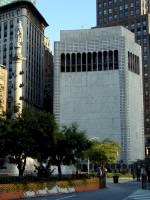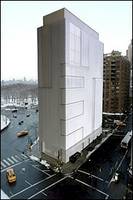Wednesday, October 13, 2004
Respect and the Forty Year Itch
 A couple weeks ago I came out of the subway at Columbus Circle and found myself looking up at Edward Durell Stone’s broadly despised 2 Columbus Circle. Even though I was in a hurry to make a stop before heading to the airport, I made myself pause to take a good look at the building because it’s not going to exist in its current state for much longer.
A couple weeks ago I came out of the subway at Columbus Circle and found myself looking up at Edward Durell Stone’s broadly despised 2 Columbus Circle. Even though I was in a hurry to make a stop before heading to the airport, I made myself pause to take a good look at the building because it’s not going to exist in its current state for much longer.
As I was standing there staring, a friend just happened to run into me. (OK, I admit it, a lot of people were running into me. This New Yorker was having an honest-to-goodness tourist moment in his hometown—standing there blocking the middle of a busy sidewalk, neck craned while gawking at the big buildings, dragging a suitcase on wheels behind him.) After we said our hellos, I asked her what she thought about the building. “I don’t know that I love it, but I remember when it went up,” she said. “It was the first building to acknowledge the Circle without turning its back on it.”
 Built in 1964 by supermarket scion Huntington Hartford to house his alternative to the Museum of Modern Art, the building has become a site of controversy recently as its new tenant, the Museum of Arts and Design, plans to rebuild the façade, essentially turning the building into something completely different than what it is today.
Built in 1964 by supermarket scion Huntington Hartford to house his alternative to the Museum of Modern Art, the building has become a site of controversy recently as its new tenant, the Museum of Arts and Design, plans to rebuild the façade, essentially turning the building into something completely different than what it is today.
Since it went up forty years ago, the building has always stirred strong responses from supporters and detractors. The fact that people have such passionate feelings about it indicates, to me, its success as a piece of architecture. The build is ugly, in an overworked, anachronistic sort of way. That’s what its detractors hate. That’s what I like.
In my view, the building has character like Tony Soprano has character. There's not another like it anywhere. You may not like it, but you recognize its power and originality. And you have to respect it. Not everyone shares my opinion, though.
There’s been enough written on the building, its place in architectural history, and its pros and cons that I don’t need to rehash that here. The new Times architecture critic, Nicolai Ouroussoff, ran a good recap on the controversy recently that summarizes the situation well. “Stone’s design,” he wrote, “and the people of this city, deserve more respect than this.”
Respect is exactly the problem here. Today 2 Columbus Circle is situated squarely in that preservation danger zone that I call the forty year itch. Every innovative object of art or design reaches a low point 40-50 years after its creation where it appears ugly, old, outdated, and in need of replacement. It’s too old to be new, and too new to be old. Styles have changed, and unless benign neglect or a passionate owner is involved, artfully designed objects tend to disappear during this window in time. People only realize the mistake later. I could list many examples, but think of the original Penn Station in New York, torn down 52 years after its construction.
More recently, American modernist and early post-modernist architectural works have started to fall into this 40-50 year danger zone. We’ve seen fights between preservationists and owners over what to do with buildings like Eero Saarinen’s TWA Terminal at JFK Airport and SOM’s under-appreciated masterpiece, the Wilde Building and corporate campus outside Hartford, CT (about which I may have more to say later this month if things go according to plan).
Although it has been listed on the National Trust for Historic Preservation’s 2004 List of 11 Most Endangered Historical Places, Stone’s 2 Columbus Circle doesn’t have the same level of support from architectural preservationists and advocates that Saarinen’s and Bunshaft’s buildings have had—primarily because the building isn’t universally appreciated by critics and practicing architects.
Should the building be re-clad with contemporary materials according to current plans, the neighborhood, the city, and American architectural history will suffer a loss. It won’t be one on the scale of Penn Station’s destruction, but it will be a loss nonetheless—a loss, ironically, caused by a lack of respect for the first building in its neighborhood to show respect for its site on Columbus Circle.